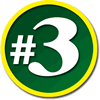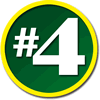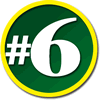1.
When a presbyopic Patient presents a new Rx, what should the Eye Care
Professional do first?
a. Review and discuss the prescription with the Patient.
b. Ask the Patient what kind of lenses they want.
c. Begin a lifestyle interview with the Patient as to their visual
habits and needs in order to determine all relevant issues as to the
design of their lenses, frame and any extra pairs.
d. Recommend a polycarbonate, hi-index, no-line, Progressive Addition
Lens, to be mounted in a designer frame.
a
only.
a and c. √
b and d.
d only.
2.
When dispensing-delivering eyewear,
which actions dominate today's optical market?
a) The store Manager checks the lay of the frame on the dispensing
table, then hands the eyeglasses to the Patient and asks him to shake
his head to check out the fit.
b) The Dispenser gives the Patient their eyeglasses, then says, "How
do they feel?"
c) The Optician places the finished eyewear on the Patient's face,
then aligns the frame front, adjusts the nosepiece, and then shapes
the temples to fit the skull for a custom fit.
d) The Dispenser aligns the eyewear from front to rear using pliers,
and then uses her hands to sculpt and reshape the temples to fit the
Patient. Then she asks for the Patient's feedback.
a
only.
a and b. √
c only.
c and d.
3. Of the Eye Care
Professionals listed, which was the first to develop into a profession?
a) Ophthalmology.
b) Opticianry. √
c) Osteopathy.
c) Optometry.
4. Which of these
O's is NOT an Eye Care Professional?
a) Orthodontist. √
b) Optometrist.
c) Ophthalmologist.
d) Optician.
5. A possible cause
leading to one eyewire fitting lower than the other might be:
1) one ear higher than the other.
2) a bent earpiece.
3) a bent shaft of the temple.
4) a bridge out of alignment.
1 only.
2 and 3.
3 and 4.
all
of the above. √
6. When utilizing the boxing system of measurement, the "B"
measurement represents the ________________.
lens depth. √
lens width.
lens difference.
effective diameter.
7. A Patient is found to have a monocular PD measuring R: 34 mm and
L: 32 mm. The box measurement of the frame selected equals 56/20.
Locate the Major Reference Point (MRP) for each eye.
R = 4 mm in; L = 6 mm in.√
R = 6 mm in; L = 4 mm in.
R = 4 mm out; L = 6 mm out.
R = 5 mm in; L = 3 mm in.
8. Which of the following best describes a semi-rimless mounting?
A front consisting of nose pads, pad arms, bridge, eyewire,
and the temples.√
A bridge and a pair of temples.
A bridge with lens bars connecting the endpieces and temples.
A center bridge, a pair of temples, and a pair of endpieces.
9. When
the measurements of a Patient's PD and the Geometric Center Distance,
GCD, are identical, the frame should be adjusted with:
positive face form.
negative face form.
retroscopic angle.
no face form. √
10. One possible method of relieving a sore nose caused by the back
edges of the nose pads is to:
tighten the tension on the temples.
flare the pads out more by spreading the back edges apart.√
bring the nose pads closer together.
raise the pad arms.
11. A frame contains 10 degrees of pantoscopic angle. Ideally, the
gaze will be directed approximately _________________ above the optical
center of the lens.
1 mm
3 mm
5 mm √
7 mm
12.
Pantoscopic angle may be increased by:
bending the nose pad arms upward.
bending the pad arms downward.
angling the temples upward from the endpieces.
angling the temples downward from the endpieces.√
13. Hands-on dispensing refers to which of these actions:
1) placing the frame directly on and off the Patient as many times
as necessary, while visually and with the sense of touch assessing
all dimensions of fitting features, and making any adjustments to
the frame, which accommodate any facial-cranial anomalies in order
to ensure long term wearability and comfort.
2) adjusting the frame so that it touches a flat surface at the 4
major points.
3) making adjustments to the frame components by hand and with the
use of hand tools.
4) handing the eyewear to the Patient and waiting for their feedback
before proceeding with any adjustments.
2 only.
1
and 3. √
2 and 4.
None of
the above.
14. The Geometrical Center Distance of a frame measuring 52/16 is:
68 mm. √
70 mm.
72 mm.
74 mm.
15. A frame
measures 50/18 and has an effective diameter of 52 mm. If the Patient's
PD measures 59 mm, the theoretical minimum blank size required is:
Minimum Blank Size (MBS) = (GCD - PD) + ED
59 mm.
61 mm. (68 mm - 59 mm + 52 mm = 61 mm) √
63 mm.
none of the above.
16. If the right temple is angled out, this will cause:
the right side of the frame to move out.
an increase in the pantoscopic angle.
the left side of the frame to move in.
the right side of the frame to move in. √
17. The frame selection criteria most suitable for use with higher
plus prescription lenses is:
smaller eye size.
rounder shapes.
small frame difference.
all of the above. √
18. "Bowing" the temples is a term used to describe __________________________.
decreasing the pantoscopic angle.
angling the temples inward.
adjusting the frame along the X axis.
curving the temples around the head. √
19. When determining the actual Minimum Blank Size, which of the following
does not need to be considered?
Possible imperfections along the periphery of the uncut lens such
as chips or bubbles.
Blank size availability from the lens manufacturer.
Vertical multifocal segment decentration.
Vertex distance. √
20. While doing a frame adjustment, you notice the bottom of the eyewires
are touching the cheeks. To remedy this situation you will:
add more face form.
spread the nose pads further apart.
decrease the pantoscopic angle. √
increase the pantoscopic angle.
21. When the measurement of the Patient's PD is less than the GCD
of the frame, it is best to adjust the frame with:
orthoscopic angle.
no face form.
negative face form.
positive face form. √
22. The front of the frame may be raised by _____________________________.
decreasing the pantoscopic tilt.
applying negative face form.
spreading the pad arms further apart.
bringing the pad arms closer together. √
23. ________________ angle exists when the bottom of the eyewire is
inclined outward, farther away from the face than the top.
Pantoscopic
Orthoscopic
Periscopic
Retroscopic √
24. In order to decrease the distance between the nose pads of a frame
it is necessary to bend the pad arms:
inward. √
outward.
upward.
downward.
25. The term DBL designates the ___________________.
temple length.
least Distance Between Lenses. √
least distance between the geometric centers of the frame.
effective diameter.
26. The frame size is 54/20 and the Patient's PD measures 66 mm. In
this case:
no face form is required.
positive face form is required. √
negative face form is required.
more information is needed.
27. What would be the "theoretical" Minimum Blank Size for
the following frame and PD combination? Box measurements: A = 52 mm;
DBL = 16 mm; ED = 53 mm; PD = 58 mm.
61 mm.
63 mm. √
65 mm.
67 mm.
28. Angling the pad arms farther apart will result in:
lessening the face form.
increasing the face form.
lowering the front. √
raising the front.
29. The "B" measurement of a frame is equal to 56 mm on
the box. A Flat Top 35 bifocal segment is fit at a height of 21 mm.
Where is the segment line positioned relative to the datum line of
the frame?
On line.
3 below.
5 below.
7 below. √
30. A frame with a saddle bridge has been selected for a child of
seven years. For which of the following reasons is this a better choice
than a comparable frame with adjustable pads?
1) A saddle bridge distributes the weight of the completed eyewear
more evenly over a greater portion of the nose area.
2) In the event of an accident, adjustable pads are more likely to
cause injury.
3) A saddle bridge retains its adjustment better than a frame with
adjustable pads.
1 only.
1 and 2.
3 only.
1,
2 and 3. √
31. If the Patient's left ear is higher than the right, and the frame
is in standard 4 point alignment, it can be expected that the frame
will fit:
so that the right eyewire is higher than the left.
so that the left eyewire is higher than the right.√
with increased pantoscopic angle.
with inadequate face form.
32. A frame with pantoscopic tilt is fit so that:
the bottom of the eyewires are closer to the face than the top of
the frame. √
the bottom of the eyewires are out farther from the face than the
top.
the bottom and top of the eyewires are an equal distance from the
face.
the temples touch the side of the head before reaching the ears.
33. Your Patient has selected a frame with the following dimensions:
A = 56 mm; B = 52 mm; DBL = 22 mm. If the segment line is dropped
6 mm below the datum line, what is the seg height?
18 mm.
20 mm. √
22 mm.
24 mm.
34. The boxing system of measurement can accurately locate the ____________
of the lens.
optical center
geometric center √
primary focal point
principal axis
35. A frame with orthoscopic tilt is fit so that:
the bottom of the eyewires are in closer than the top.
the bottom of the eyewires are out farther than the top.
the bottom and top of the eyewires are an equal distance
from the face. √
the temples touch the side of the head before reaching the ears.
36.
Where would you prefer to purchase your eyewear?
1) The neighborhood merchandise-optical store with a staff of young
Optical Dispensers and a department Manager with no optical experience.
2) The Optical Outlet that advertises free eye exams and 2 for 1 priced
eyewear.
3) A local Vision Center that designs eyewear
to suit visual tasks and where the eyewear is custom fit.√
4) Any discount Drug Store with $5.99, ready-to-wear eyeglasses.
37.
Where would you prefer to take your eyewear for service and custom
fitting?
1) Any Optical Outlet that advertises free eye exams and 2 for 1 priced
eyewear.
2) A Vision Center that designs eyewear to suit visual tasks
and where the eyewear is custom fit. √
3) A local discount Drug Store with $9.99, ready-to-wear eyeglasses.
4) The local merchandise-optical store with a staff of latter generation
Optical Dispensers.
38.
Match the ophthalmic professions with the descriptions.
1) Ophthalmologist - c √
2) Optician - a √
3) Orthopedist - d √
4) Optometrist - b √
a)
Specializes in the design of lenses and the dispensing of eyewear.
b) Specializes in the refraction of the eye for visual acuity error.
c) Specializes in surgery and medical treatment of the eye.
d) Specializes in surgery and medical treatment of the feet.
39.
A Patient, after looking at numerous frames, makes their final selection
of a frame with temples that are too short. The Dispensing Optician
should:
a) ignore the issue for fear of losing the sale.
b) insist that the Patient make a different choice.
c) advise the Patient of the fitting issues
and consequences, then let them decide. √
d) advise the Patient to go to a competitor for a different selection
of frames.
40.
An adolescent athlete Patient and his family want to purchase his
eyewear. They select a semi-rimless frame with plastic lenses. The
Dispensing Optician should:
a) insist that the Patient choose a more appropriate frame.
b) ignore the obvious deficiencies for fear of losing the sale.
c) advise the Patient of the safety issues and consequences, then
let him decide.
d) advise the Patient and family of
her policy requiring polycarbonate lenses, along with an athletic
frame, to avoid putting the Patient at risk of injury. √
41.
An Optician can optimize the fit of a frame with Gross Frame Alignment
first, followed by Subtle Frame Adjustments. The Subtle Frame Adjustments
are accomplished by:
a) bending the temples 90 degrees at the top of the ear so the frame
won't fall off.
b) handing the eyeglasses to the Patient and waiting to see how they
respond.
c) handcrafting the frame using hand tools,
and a frame warmer but mostly the hands. √
d) leave it up to the optical lab to square the frame when they
do their final inspection.
42.
Your Patient complains of their eyeglasses being too loose while you
are performing a zyl frame adjustment, you can see spacing, and you
can feel gaps where there is no contact between the Patient's mastoid
and both temple ends. To remedy this situation you will:
a) bend the temples closer to the top of the ear for a tighter fit.
b) have the Patient shake their head to see if any adjustment is really
necessary.
c) handcraft the temples using your hands,
with the aid of a frame warmer, to reshape the temples to match
the curves of the Patient's skull for total contact. √
d) straighten the temples so they fit, library style, around
the back of the Patient's head.
43.
With your assistance a Patient selects a new frame which fits squarely
with standard alignment. While measuring the patient for multifocal
lenses it is determined that the left eye is 2 mm higher in relation
to the frame-face alignment. To compensate for this anomaly you will:
a) ignore the anomaly and order the seg heights to be equal in both
lenses, as usual, so they appear to be equal upon anyone's inspection.
b) ignore the anomaly and say nothing so that the Patient is not embarrassed.
c) align the frame so that the left eyewire will be higher, making
the segs vertically equal even though the frame is tilted off axis.
d) advise Patient that eye and ear anomalies
are common, and that you will order the left reading segment 2 mm
higher than the right so that the they can gaze through the same
reading portion of each lens simultaneously for a more balanced
visual experience. √
44.
How many items of equipment and tools are required to be maintained
in each office by a Florida Licensed Optician?
a) Only those determined to be necessary by the Manager.
b) 21.
c) As many tools as the Optician desires.
d) Ten. √
45.
What is a colmascope?
a) A device used for reading the power of glass lenses.
b) A device used to confirm a Polaroid lens.
c) A device use to detect the stress pattern
of case hardened glass lenses. √
d) A device which is attached to a microscope for additional magnification.
The
following questions are optional.
Contact us here for an evaluation, if you wish.
46.
A patient presents you with the following multifocal Rx:
O.D.
+0.25 +2.75 x 175
O.S.
Plano +2.75 x 95
Add
+2.50 O.U.
The patient wishes to purchase multiple pairs of eyeglasses.
a)
Do you foresee any adverse issues for this patient based on this
Rx? If so, what are they?
b)
Will you advise the patient to proceed with the purchase of multiple
pairs?
c)
If not, what options will you advise this patient to consider?
47.
Do you think today's Eye Care Professionals are adequately trained
in hands-on, in-place,
on-the-face assessment and fitting
of corrective eyewear?
48.
If no, what can be done about it?
49.
Do you routinely conduct a Full Discovery Lifestyle Interview of
your Patients? If yes, briefly state the procedure.
50.
Do you know what a Progressive Lens Demonstration Kit is? If yes,
briefly explain how often you use it, i.e., all presbyopic Patients,
only selected Patients? (Get
free advice and-or training here.) --
See DispensingGuidelines.com.
 Lensmeter Factoids
Lensmeter Factoids
 Lensmeters can be operated manually or automatically.
Lensmeters can be operated manually or automatically.
 There are two types of lensmeter targets: a) Circle of dots, and
b) Crossed lines.
There are two types of lensmeter targets: a) Circle of dots, and
b) Crossed lines.
 Green filters were added in the early 1900s to reduce chromatic
aberration.
Green filters were added in the early 1900s to reduce chromatic
aberration.
 The American Optical Company introduced the AO Lensometer in 1921.
The American Optical Company introduced the AO Lensometer in 1921.
 Projection technology lensmeters have been introduced but never
widely used.
Projection technology lensmeters have been introduced but never
widely used.
 Gas-Oxygen permeable contact lens powers can be verified with a
lensmeter by placing the concave side of the lens on the stop and
reading the power.
Gas-Oxygen permeable contact lens powers can be verified with a
lensmeter by placing the concave side of the lens on the stop and
reading the power.
See Letter to Eye Care Professionals.
We
welcome your comments. 
